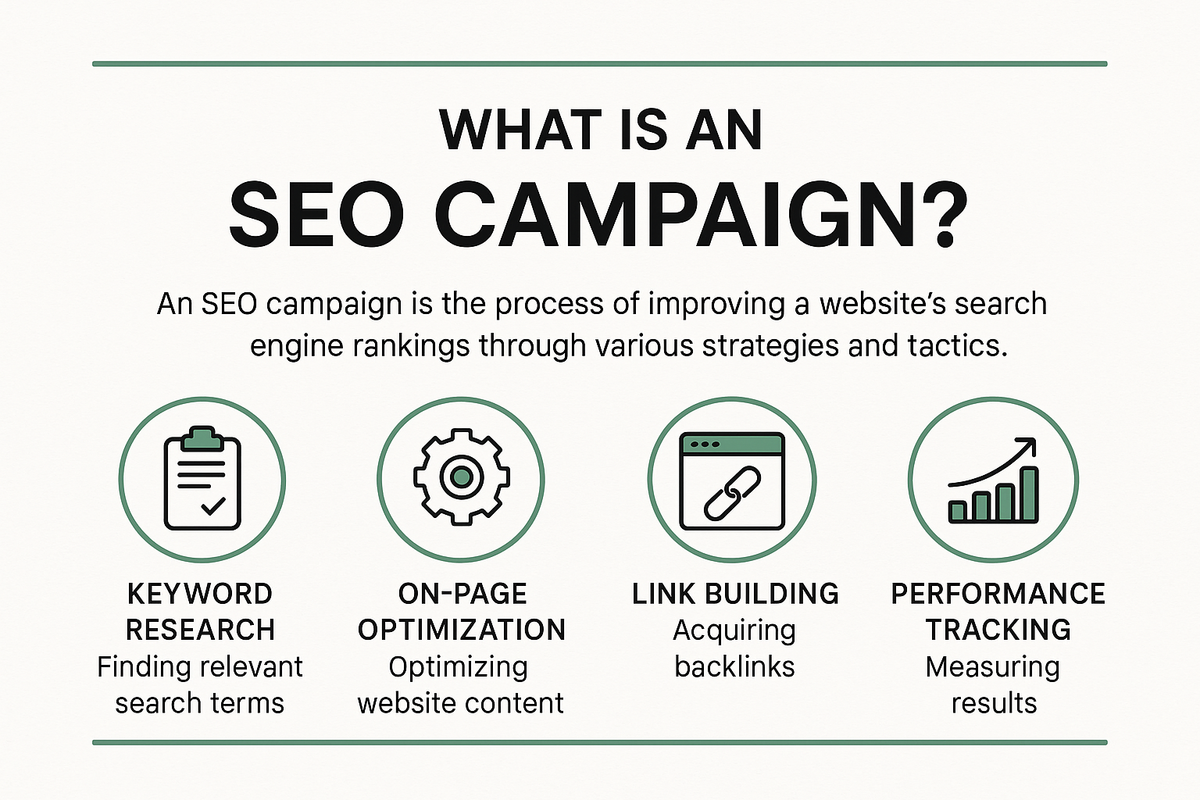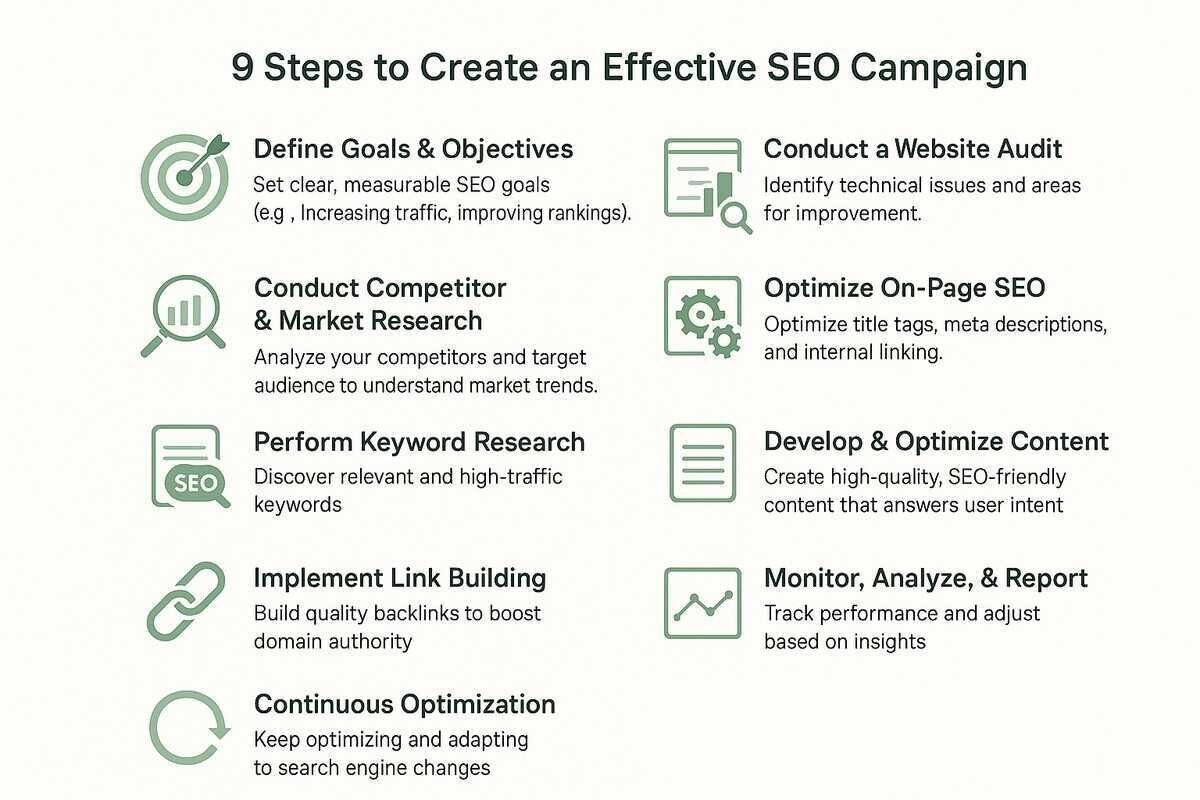An SEO campaign is more than simply adding keywords to a few web pages, it’s a strategic, data-driven journey to position your website where your audience can easily find it.
At its core, it combines in-depth keyword research, compelling content creation, technical improvements, and authority-building to earn higher rankings in search results.
Therefore, by optimizing your site for speed, security, and mobile usability, ensuring your content matches the intent of your target audience, and securing high-quality backlinks, an SEO campaign works to make your website both search engine–friendly and user-focused, while delivering long-term benefits of SEO that strengthen visibility and credibility.
Unlike paid advertising, the goal isn’t instant clicks, it’s long-term, sustainable growth.
That said, a successful SEO campaign adapts to ever-changing algorithms, keeps pace with shifting market trends, and continually refines its approach.
The result is increased visibility, stronger credibility, and a steady flow of high-quality visitors who are more likely to convert into loyal customers.
So, What Is an SEO Campaign? It's a comprehensive strategy that focuses on long-term growth and user engagement rather than short-term results.
Book Your Free Expert Consultation
What is an SEO Campaign?
An SEO campaign is a structured, strategic process aimed at improving a website’s visibility on search engines like Google, Bing, or Yahoo.

Its primary purpose is to attract high-quality organic traffic by ranking for keywords that are closely aligned with the business’s products, services, or content, often achieved through professional SEO services that tailor strategies to business goals.
Unlike one-time SEO fixes, an SEO campaign is goal-driven, ongoing, and measurable, requiring sustained effort to achieve long-term success.
That said, a successful SEO campaign combines several interconnected strategies, each playing a vital role in boosting both search engine rankings and user experience:
- Keyword Research – Identifying the most relevant, high-value search terms that align with the target audience’s intent.
- Technical SEO Optimization – Ensuring the website is fast, mobile-friendly, secure, and easy for search engines to crawl and index.
- Content Creation & Optimization – Producing engaging, valuable, and keyword-optimized content that answers user queries and ranks well.
- Link Building – Acquiring high-quality backlinks from authoritative websites to strengthen the site’s credibility and domain authority.
All of these components are guided by data and analytics, allowing for continuous refinement to maximize visibility, drive targeted traffic, and deliver measurable business results over time, which is why many businesses partner with a Top digital marketing agency to manage and scale these efforts effectively.
7 Key Components of a Successful SEO Campaign
Building upon the foundation of understanding what an SEO campaign is, it’s essential to explore the specific elements that contribute to its success. A well-structured SEO campaign incorporates several critical components, each playing a vital role in improving search visibility and driving organic traffic.
A successful SEO campaign includes several key elements:
1. Keyword Research and Strategy
Identifying relevant search terms and phrases used by the target audience to find products or services is essential. This forms the foundation of your SEO campaign strategy and sets the direction for content development and optimization.
2. On-Page Optimization
This involves refining the website’s content, structure, and HTML elements (such as title tags, meta descriptions, and header tags) to align with target keywords and improve search visibility. Effective SEO campaign management includes a focus on these on-page elements to enhance rankings.
3. Content Creation
Developing high-quality, relevant content that addresses user intent and naturally incorporates target keywords is critical. This could include blog posts, articles, product descriptions, and more. A strong content strategy is a core part of many SEO campaign examples where content plays a pivotal role in driving organic traffic.
4. Technical SEO
Ensuring the website is crawlable, indexable, and free of technical issues is crucial. This includes optimizing site speed, mobile-friendliness, and URL structure. For effective SEO campaign management software, ensuring the technical health of a site is often a key feature to consider.
5. Link Building
Acquiring authoritative backlinks from reputable websites helps improve the site’s credibility and authority, which directly impacts search rankings. SEO campaign examples often highlight the importance of building strong, relevant backlinks.
6. Local SEO
For businesses targeting specific geographic areas or those with physical locations, optimizing for local search results is crucial. This includes managing Google Business Profile, local citations, and reviews to boost local rankings. SEO campaign meaning expands to include these localized efforts for businesses focusing on regional audiences.
7. Analytics and Reporting
Monitoring key performance metrics, analyzing results, and adjusting the strategy based on data-driven insights is essential to refine and optimize an SEO campaign. Utilizing SEO campaign management software can help streamline this process, offering tools to track progress and adjust strategies accordingly.
By focusing on these core components, SEO professionals can develop an effective SEO campaign that drives organic traffic, enhances search visibility, and improves rankings in search results. The synergy between these elements is the backbone of a robust SEO campaign strategy, ensuring long-term success in the competitive digital landscape.
9 Steps to Create an Effective SEO Campaign
Define clear goals, conduct thorough keyword research, optimize on-page and technical SEO, create high-quality content, build authoritative backlinks, and continuously monitor and adjust based on performance.

1. Define Goals & Objectives
The first step in creating an effective SEO campaign is to clearly define the goals and objectives. This ensures that all efforts are aligned toward a common purpose and helps measure success.
Identify what success looks like for your SEO campaign.
- Common goals may include:
- Increasing organic traffic by a specific percentage (e.g., 20% in 6 months), achieving a top 3 google keyword ranking for specific keywords, generating more conversions, and enhancing brand visibility.
- Achieving a top 3 ranking for specific keywords
- Generating more conversions (sales, sign-ups, or leads)
- Enhancing brand visibility in specific markets or niches
These goals should be specific, measurable, achievable, relevant, and time-bound (SMART goals).
To track progress and measure the success of your SEO campaign, it’s essential to define KPIs. These indicators will provide insights into how well your campaign is performing, especially when SEO efforts are integrated with complementary web design and development services that enhance usability and conversions.
Common KPIs include:
- Track the positions of targeted keywords in search engine results.
- Measure the volume of traffic coming from search engines.
- Monitor how many visitors take the desired actions (e.g., making a purchase, signing up).
- Track the percentage of visitors who leave after viewing only one page, which can indicate issues with user engagement or page quality.
2. Conduct Competitor & Market Research
An effective SEO campaign, conducting competitor and market research is essential for understanding the competitive landscape.
Start by identifying both direct competitors (businesses offering similar products or services) and SEO competitors (websites targeting the same keywords).
Using tools like SEMrush, Ahrefs, and other SEO ranking report tools, analyze their top keywords, backlink profiles, and content strategies to uncover what is driving their rankings and traffic.
This allows you to identify opportunities for your own site. Additionally, leveraging Google Trends helps spot market trends and understand the seasonality and demand for specific keywords, providing insight into how market dynamics might influence your SEO strategy.
This research helps you align your campaign to not only compete effectively but also seize gaps in your market for maximum visibility.
Get Your Free SEO Audit Report Today!
3. Perform Keyword Research
In this step, focus on selecting the right keywords to target for your SEO campaign. Start by using tools like Google Keyword Planner, Ahrefs, or SEMrush to discover keywords relevant to your business that have high search volume and low competition.
Pay close attention to search intent, ensuring that your target keywords align with user motivations, much like how to search for words on a page helps uncover precise matches in content. Whether they're looking for information (informational), ready to make a purchase (transactional), or navigating to a specific site (navigational).
Finally, categorize keywords based on their relevance to specific pages on your website, such as assigning broader terms to your homepage, detailed product-related keywords to product pages, and niche or long-tail terms to blog posts.
This structure ensures that each page on your site is optimized to attract the right audience and match their search intent effectively.
4. Conduct a Website Audit
Conducting a website audit is essential to identify and fix technical and on-page SEO issues that can affect your site's performance. Key actions include:
- Technical SEO Check: Use tools like Google Search Console, Screaming Frog, and Ahrefs to identify issues.
- Crawlability: Ensure search engines can access and index your site properly.
- Site Speed: Improve load times using Google PageSpeed Insights to enhance user experience and SEO.
- Mobile Optimization: Ensure your site is mobile-friendly, as mobile-first indexing is now prioritized by search engines.
- Fix Broken Links: Identify and resolve broken links that could harm both SEO and user experience.
- Address Duplicate Content: Eliminate duplicate content issues that can confuse search engines and lower rankings.
- On-Page SEO Check: Review and optimize title tags, meta descriptions, and URL structures to align with targeted keywords, while applying noindex where necessary to prevent low-value pages from being indexed.
These actions ensure that your site is technically sound and ready to perform well in search rankings.
5. Optimize On-Page SEO
To optimize on-page SEO, focus on ensuring that each element of the page is aligned with both user intent and search engine requirements.
Key actions include:
- Make sure each page has a unique, keyword-optimized title tag and meta description that accurately describe the content and encourage clicks.
- Keep URLs short, descriptive, and include the target keyword (e.g., /seo-strategy-guide).
- Use H1 for page titles and H2/H3 for subheadings, ensuring that keywords are naturally integrated into the text.
- Write high-quality content that addresses user queries, naturally incorporates targeted keywords, and enhances the page with multimedia (images, videos) to improve engagement and user experience, reflecting the same principles applied in professional organic SEO services.
- Add internal links to other relevant pages on your website, distributing authority across pages and improving overall site navigation.
By focusing on these aspects, you enhance the relevance, usability, and crawlability of your pages, increasing their chances of ranking higher in search results.
6. Develop & Optimize Content
Creating and optimizing content is crucial to ensure your website meets both user and search engine needs. Key steps include:
- Develop blog posts, case studies, videos, and landing pages that are aligned with your target keywords and provide value to your audience.
- Aim for in-depth, valuable content (usually 1000+ words) that comprehensively covers the topic and provides answers to user queries.
- Use keywords naturally within the content, ensuring they fit contextually and provide value, avoiding keyword stuffing that can lead to penalties.
- Regularly update existing content to keep it fresh and relevant, ensuring that your website maintains authority and ranks for up-to-date queries.
- Use Latent Semantic Indexing (LSI) keywords, which are related terms or synonyms, to enhance the content’s semantic relevance and improve its ability to rank for a variety of search terms (e.g., "SEO tips" could include terms like "search engine optimization" or "website ranking strategies"), similar to explaining how does shopify work in multiple contexts to improve clarity and search reach.
By focusing on these steps, your content will not only be optimized for search engines but also provide genuine value to your audience, increasing engagement and driving more organic traffic.
Explore Our Content Marketing Services!
7. Implement Link Building
Link building is an essential part of off-page SEO, helping to improve your website's authority and visibility. Key strategies include:
- Focus on acquiring links from high-authority, relevant websites that are trusted by search engines, as these will boost your site’s credibility.
- Write guest articles for industry blogs or authoritative websites, providing value and including links back to your site.
- Find broken links on authoritative sites and offer your content as a replacement, helping both the site owner and your SEO efforts.
- Partner with influencers or thought leaders in your industry to get backlinks from their trusted platforms, increasing your site’s authority and reach like the best lead generation for realtors relies on trusted networks to drive qualified prospects.
- Ensure your business is listed in relevant local directories and that your NAP (Name, Address, Phone) information is consistent across platforms for better local SEO.
By using these link-building strategies, you increase your site’s domain authority, improve rankings, and enhance your overall SEO performance.
8. Monitor, Analyze, & Report
Monitoring and analyzing the performance of your SEO campaign is essential to ensure it’s achieving its objectives.
Start by tracking keyword rankings and traffic using tools like Google Analytics, Google Search Console, and Ahrefs to monitor progress and identify areas for improvement.
Next, analyze key data to assess if the campaign is meeting its KPIs. Look at important metrics such as organic traffic, conversion rates, bounce rates, and pages per session to evaluate how well your site is engaging visitors and driving results.
Monthly reporting is crucial for providing a comprehensive overview of the campaign's performance, summarizing progress against KPIs, offering insights into what's working, and identifying areas that need improvement and helping you evaluate results against your investment, much like comparing SEO audit pricing options before committing to a service.
9. Continuous Optimization
Continuous optimization is crucial to maintaining and improving the performance of your SEO campaign.
Start by adjusting your keyword strategy, adding new keywords or targeting long-tail variations based on performance data to ensure you’re capturing all relevant search opportunities.
Next, focus on content refresh by updating underperforming content and revising outdated articles to keep them valuable and relevant for both users and search engines, aligning efforts with what is the digital marketing strategy that tracks users across the web? in order to meet evolving audience behavior.
Finally, rebuild your backlink profile by consistently acquiring high-quality backlinks from authoritative sources, which helps maintain or improve your website’s rankings.
By regularly optimizing these aspects, your SEO campaign stays aligned with evolving trends, maintaining long-term success.
5 Common SEO Campaign Mistakes to Avoid
Common SEO campaign mistakes to avoid include ignoring search intent, targeting overly competitive keywords without authority, neglecting technical SEO, creating thin or duplicate content, and failing to track ROI.
- Ignoring Search Intent: Focusing solely on keywords without considering the searcher’s intent can lead to irrelevant traffic that doesn’t convert, similar to misunderstanding what is b2c sales and missing how consumers actually make purchasing decisions.
- Targeting Overly Competitive Keywords Without Authority: Trying to rank for highly competitive keywords without sufficient domain authority or backlinks can lead to wasted effort and poor results.
- Neglecting Technical SEO: Failing to address technical issues like crawlability, mobile optimization, and site speed can severely limit your campaign’s effectiveness.
- Creating Thin or Duplicate Content: Publishing low-quality, thin content or duplicating existing content can harm rankings and fail to provide value to users.
- Not Tracking ROI: Failing to measure the return on investment (ROI) can lead to an unclear understanding of what’s working, hindering the ability to adjust and optimize the campaign.
Avoiding these common mistakes ensures your SEO campaign remains focused, effective, and aligned with best practices.
How To Measure SEO Campaign Success?
Following the implementation phase of an SEO campaign, the focus shifts to evaluating its effectiveness. This crucial step enables data-driven refinements and demonstrates the value of SEO efforts to stakeholders.
Tracking and measuring the results of an SEO campaign is vital to understand its effectiveness and make necessary improvements.
Key metrics to focus on when evaluating an SEO campaign’s success include:
- Organic search traffic: Monitor increases in visitors coming to the site through search engines.
- Keyword rankings: Track how target keywords are performing in search results over time.
- Conversion rate: Measure the percentage of organic visitors taking desired actions on the site.
- Backlink profile: Analyze the quantity and quality of inbound links the site is earning.
- Page load speed: Ensure optimized pages load quickly for users.
- Bounce rate: Check if visitors are engaging with the content or leaving quickly.
- Click-through rate (CTR): Evaluate how compelling search listings are to users.
Effective SEO campaign management involves regularly reviewing these metrics and adjusting the strategy accordingly. Tools like Google Analytics and Google Search Console should be used to gather data, and investing in SEO campaign management software can provide more comprehensive tracking and reporting.
Clear, measurable goals should be set at the outset of the SEO campaign, and results should be compared against these benchmarks. This allows for a demonstration of ROI and identification of areas for improvement. It’s important to remember that SEO campaigns are long-term strategies, so the focus should be on trends over time rather than short-term fluctuations.
By consistently measuring and analyzing SEO campaign performance, tactics can be refined, resources allocated more effectively, and ultimately better results can be achieved through organic search. This ongoing process of measurement and refinement is key to long-term SEO campaign success, as illustrated by real-world SEO campaign examples.
SEO campaign management software plays a vital role in this process by offering tools to track, analyze, and optimize every aspect of an SEO campaign. Whether you're looking to define the meaning and goals of your SEO campaign, track keyword rankings, or measure other key performance indicators, utilizing the right software can make all the difference.
Why an SEO Campaign is a Long-Term Investment?
An SEO campaign is a long-term investment because it focuses on building lasting visibility, credibility, and organic traffic over time.
Unlike paid ads, which stop delivering results the moment you stop paying, SEO creates a strong foundation through quality content, technical optimization, and backlinks that continue to attract visitors for months or even years.
The longer you maintain and refine your SEO efforts, the stronger your rankings become, much like what is b2b marketing, where long-term relationship building secures consistent growth, making it harder for competitors to outrank you and ensuring sustained business growth.
FAQs: What Is an SEO Campaign?
What Does an SEO Campaign Include?
An SEO campaign includes several key components such as keyword research, on-page optimization, technical SEO, content creation, link building, and performance tracking. These elements work together to improve search rankings, enhance user experience, and increase organic traffic.
Can You Share Some SEO Campaign Examples?
SEO campaign examples often include businesses that improve their online presence through keyword optimization, content creation, and link-building efforts. For instance, an e-commerce site might target specific product-related keywords to rank higher in search results, leading to more traffic and increased sales.
What Is the Definition of an SEO Campaign?
The definition of an SEO campaign refers to a well-organized strategy aimed at enhancing a website's search engine rankings through a series of actions like keyword research, technical improvements, content optimization, and link building to attract more organic traffic over time.
What Is the Meaning of an SEO Campaign?
The meaning of an SEO campaign is to implement a comprehensive set of strategies to increase a website’s organic visibility, targeting relevant search queries to attract more traffic, and ultimately convert visitors into customers or leads, ensuring long-term success.
What Is SEO Campaign Management Software?
SEO campaign management software helps digital marketers track, manage, and optimize their SEO efforts. It provides tools to monitor keyword rankings, analyze competitor data, check site health, and generate reports, all of which help refine and adjust SEO strategies for better results.
Conclusion
An SEO campaign is far more than a race to the top of search engine results, it’s a comprehensive strategy that combines deep audience understanding with continuous website improvement. When executed effectively, an SEO campaign follows a structured approach that starts with thorough keyword research to uncover high-value search opportunities. Content creation and optimization come next, producing valuable, relevant material that not only ranks well but also engages and informs visitors.
Link building strengthens this foundation by increasing your website’s authority through credible, high-quality backlinks. Rather than relying on short-term tactics, it creates a self-reinforcing cycle: improved rankings lead to more traffic, more traffic leads to higher engagement, and higher engagement signals greater relevance to search engines. This ongoing process not only boosts visibility but also improves user experience and conversion rates, much like performance marketing, where measurable outcomes and data-driven strategies ensure your business continues to reap long-term benefits well after the initial campaign efforts. So, What Is an SEO Campaign? It’s a methodical approach focused on sustainable growth, improving both search engine rankings and user experience to achieve lasting results.









